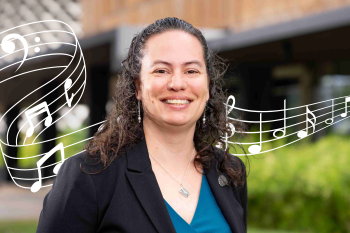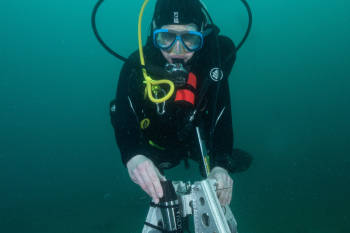© Pint of Science, 2025. All rights reserved.
Australia in Space
From 4 to 10 October 2025 astronomers, astrophysicists and astro-enthusiasts of all kinds will mark World Space Week. Established by a United Nations resolution, the week is an occasion to celebrate the myriad contributions of space science and technology to human life.
The dates of space week are not arbitrary. The start of the week recalls the launch of the first human-made satellite to orbit Earth, on 4 October 1957, and the end of the week harks back to the signing of the United Nations outer space treaty just over a decade later, on 10 October 1967. Since then, space technology has come a long way.

Image source: GPS U.S. Space Force Website
Finding our way
In today’s technology driven world, GPS is an acronym you’re probably familiar with. However, this global positioning system (GPS) is only one form of what are known as global navigation satellite systems (GNSS). The first GPS satellite was launched in 1978, originally for military use, and by 1993 a full constellation of 24 satellites was operational.
Data from satellites is collected at ground stations strategically positioned around the world. Geoscience Australia operates one such station in Alice Springs, one of only three outside of the United States. The two antennas at the site are even painted!
Today, the satellite data collected at these stations plays a role in everything from tracking your morning run to global telecommunications and emergency management. As the resolution of satellite imagery has improved, its potential applications have expanded, and it’s now a powerful resource for monitoring the Earth’s environment.
Facing fire and flood
Australia is no stranger to natural disasters, and satellite data is playing an increasing role in monitoring and response efforts. Of particular use is the NovaSAR-1 satellite, which CSIRO shares the operation of with international partners. This satellite has the capacity to take images day and night, through clouds and smoke.
Following the 2019-20 bushfires, researchers used NovaSAR-1 imagery to map the extent of burnt areas and have since collected baseline imagery for the Australian landmass as a whole. In a similar vein, following flooding across Queensland and New South Wales in 2025, images were also used to generate interactive before-and-after comparisons of land impacted by floodwaters. Accurately mapping the extent of impact in these ways can then inform targeted response activity.
Satellite data also comes in handy in real time. A national bushfire monitoring system, the Digital Earth Australia Hotspots map, has been developed using data from thermal sensors on orbiting satellites to identify areas at particular risk of fire. The spots themselves aren’t markers of fire (only increased heat), but resources like these certainly mark an advance in technology from fire lookout trees.
On a global scale, a newly launched satellite known as NISAR will gather data night and day, through cloud and smoke, for researchers around the world studying the Earth’s oceans, ice and vegetation alike.
Sustaining space activity
The world has undoubtedly become reliant on space technology. The many forms of this technology also have a role to play in achieving all 17 of the Sustainable Development Goals.
However, with increased numbers of satellites old and new comes increased space debris. As of September 2025, the European Space Agency estimate the existence of more than 54,000 space objects bigger than 10 centimetres, along with millions of smaller fragments.
In space even tiny flecks of paint can have a significant impact. The International Space Station has been ‘hit’ before and ongoing surveillance is needed to determine when it might have to move out of the way.
Of course, the more pieces of debris there are, the higher the risk of collision, which in turn can create more space debris – a space junk spiral, if you will.
To date, space waste management remains a challenge (as, indeed, waste management is on Earth), but Australian researchers are playing a part in the response. A startup based at the University of South Australia is working on a way to capture space debris and store it on satellites for recycling. Debris surveillance and collision avoidance is also a key research focus of RMIT University’s space research centre in Melbourne.
To learn more about World Space Week and find an event near you, visit the homepage.
References
Advanced Navigation (2023). Global Navigation Satellite System (GNSS) and satellite navigation explained. https://www.advancednavigation.com/tech-articles/global-navigation-satellite-system-gnss-and-satellite-navigation-explained/.
CSIRO Centre for Earth Observation. (n.d.). NovaSAR-1. https://research.csiro.au/cceo/novasar/
CSIRO. (n.d.). Bushfire tracking with Sentinel Hotspots. https://www.csiro.au/en/research/disasters/bushfires/sentinel-hotspots
Geoscience Australia. (2024, December 4). Our satellite and ground station network. https://www.ga.gov.au/scientific-topics/space/our-satellite-and-ground-station-network
Luke, C. (2021, September 6). What is Space Junk and What Can We Do About It? Earth.org. https://earth.org/space-junk-what-is-it-what-can-we-do-about-it/
NASA Science. (2025, July 22). Mission Overview – NISAR Quick Facts. https://science.nasa.gov/mission/nisar/mission-overview/
NASA. (2020). ARES Orbital Debris Program Office. https://orbitaldebris.jsc.nasa.gov/faq/
Petrie, S. (2025, June 15). A 3-tonne, $1.5 billion satellite to watch Earth’s every move is set to launch this week. The Conversation. https://theconversation.com/a-3-tonne-1-5-billion-satellite-to-watch-earths-every-move-is-set-to-launch-this-week-258283
RMIT University. (n.d.). Research areas. Research areas - RMIT University
United States Government. (n.d.). GPS Block IIR(M) satellite. https://www.gps.gov/multimedia/images/IIR-M_2.jpg
University of South Australia. (2025). World-first reusable space debris collector set to revolutionise sector. https://unisa.edu.au/media-centre/Releases/2025/world-first-reusable-space-debris-collector-set-to-revolutionise-sector/
World Space Week. (n.d.). https://www.worldspaceweek.org/about/




